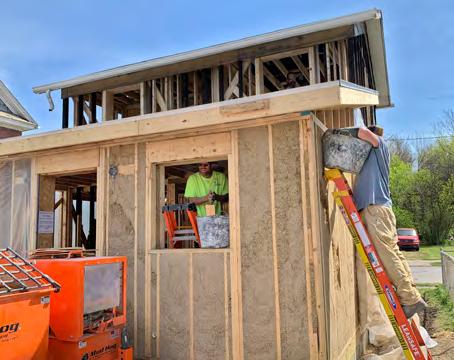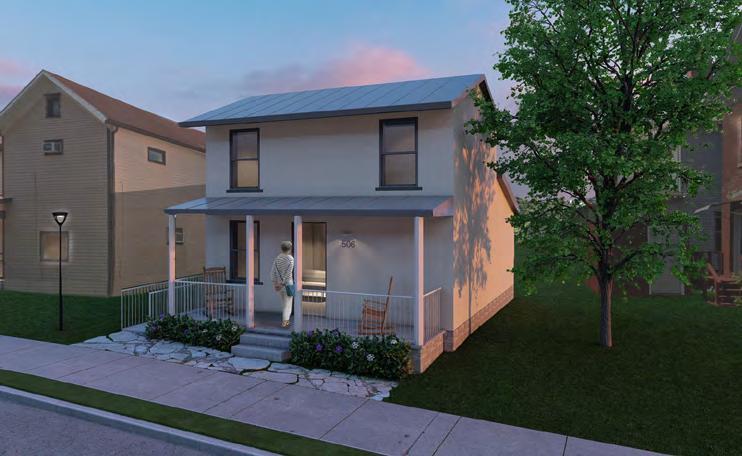
6 minute read
HOME FOR GOOD: A HEALTHIER
from re:D Magazine 2021


TOP: Project partner DON Enterprise recently purchased 506 Spruce Street to convert the property into a low-cost, nontoxic home for people with disabilities. MIDDLE: Perimeter walls like this one, made with sprayed-in HempLime, typically contain a variety of materials, which introduce added cost and toxics. BOTTOM: Lori Daytner, of the nonprofit developer DON Enterprise; Cameron McIntosh, of the hemp-building firm Americhanvre; HML research fellow Meryl Smith; and HML co-founder and design director Jonsara Ruth outside of 506 Spruce Street.
Home for Good
A Healthier Future for Affordable Housing
Passing by 506 Spruce Street in New Castle, Pennsylvania,
you might think this early-20th-century house in the former manufacturing capital was simply getting a freshening up. The 800-square-foot dwelling is in fact the site of cutting-edge design and construction research led by Parsons’ Healthy Materials Lab in collaboration with local community partners. But to witness the home’s radical innovations firsthand, you would need to take a chainsaw to a side of the building.
In a typical freestanding American home, an exterior wall has as many layers as the functions it performs. Wood framing is placed between panels and sheets dedicated to waterproofing, blocking drafts, insulating interiors, and finishing surfaces. While the assembly encloses a space effectively, the many individual components add cost and often harm occupants: The building products typically contain known asthmagens, endocrine disruptors, and other compounds that damage human health. Even lumber usually contains endocrine-disrupting flame retardants.
The mission of Parsons’ Healthy Materials Lab (HML) is to reduce human exposure to such chemicals, especially in affordable housing. Jonsara Ruth, who co-founded HML with Alison Mears, says this work reached a turning point in 2017, two years after the collective’s launch. Observing that healthful materials advocacy focused on products that contain toxic substances, Ruth recalls realizing that “removing one harmful ingredient at a time is an important but slow process. So we convened a group of student researchers to identify available building products that best safeguard health.”
This shift in HML’s perspective—from mitigating the effects of toxic substances in mass-market materials to promoting healthful alternative products—soon led the team to HempLime, a material made from hemp’s woody fibers; lime, a silica material from limestone; and water. The biodegradable mixture can be cast or blown into wall cavities to perform the functions of several layers of a typical wall section. It is naturally mold resistant, flame retardant, antimicrobial, vapor regulating, and insulating. Instead of off-gassing, HempLime continuously absorbs airborne toxics, even sequestering carbon
dioxide. HML’s Trace Material podcast refers to HempLime as a “superstar” of the healthful materials toolbox.
A multipurpose plant, hemp has been grown in the United States since the 17th century but was banned in 1970 for sharing a species category with marijuana. Because industrial hemp production was re-legalized federally only in 2018, HempLime’s benefits have not yet been thoroughly documented, and designers and builders are only now learning how to use it in conjunction with standard wall section components. In 2019, HML discovered a fellow HempLime champion in the organization DON Enterprise, which renovates and develops affordable, accessible housing in New Castle for people with disabilities. The nonprofit recognized that the material could improve the lives of its residents while revitalizing the local agricultural economy, and it teamed with HML to explore HempLime’s building applications, ultimately leading to the renovation at 506 Spruce Street.
The collaboration began in earnest in January 2020, when classes conducted by HML and Parsons’ Master of Architecture (MArch) program charged students with designing affordable housing for a New Castle site using HempLime as a building material. Inspired by those proposals, DON then tapped HML to prototype a renovation. With Meryl Smith—an MArch student who participated in the HempLime Architecture Studio in spring 2020—Mears and Ruth developed architectural and construction plans in which HempLime blown into the existing balloon frame simplifies the traditional sandwichlike wall section. Mears explains that the interiorfacing wall is then finished with locally sourced lime plaster applied directly to the HempLime. The exterior locally milled hemlock boards, which are visible from the street and set off slightly from the wood frame, serve as a rainscreen; the air barrier between the two surfaces prevents mold from developing inside.
Although the project is just wrapping up, its transformative potential has already attracted considerable notice. The Pennsylvania Housing Research Center has signed on to monitor 506 Spruce Street’s performance, and the groundbreaking renovation method is featured in the television series America by Design, which began airing in June.
newschool.edu/red/hml
HempLime sprayed into spaces between wood framing replaces a number of layered wall components with an affordable, nontoxic, and breathable material.


A rendering of the completed renovation at 506 Spruce Street, where HempLime insulates the house and provides a surface for breathable interior wall finishes.
EXECUTIVE EDITOR
Anne Adriance
EDITORIAL BOARD
Jen Rhee, MA Media Studies ’13; Yvette Sobky Shaffer; Yolanda Urrabazo; Simone Varadian
PARSONS ADVISORY BOARD
Shana Agid, Ben Barry, Rhonda Garelick, Cynthia Lawson Jaramillo, David J. Lewis, Rachel Schreiber
MANAGING EDITORS Kyle Hansen, Audrey Singer
EDITOR AND LEAD WRITER
John Haffner Layden
CONTRIBUTING WRITERS
Hannah R. Brion, Megan M. Garwood, Lilit Markosian, David Sokol
LEAD DESIGNER
Jamie Ficker
PRODUCTION COORDINATORS
Steven Arnerich, Sung Baik
COPY EDITOR
Leora Harris
PRODUCED BY
Marketing and Communication, The New School
LETTERS AND SUBMISSIONS
re:D welcomes letters and submissions. Include your year of graduation, the degree completed, and your major or program. Unsolicited materials will not be returned.
CONTACT US/ADDRESS CHANGES
re:D, Parsons School of Design, 79 Fifth Avenue, 17th floor, New York, NY 10003; red@newschool.edu
REGARDING DESIGN, SEPTEMBER 2021 POSTMASTER
Send address changes to Regarding Design (re:D), 55 West 13th Street, New York, NY 10011.
CREDITS
Cover—Myles Loftin, BFA Photography ’20; News— Abrams, ADIFF, Luis Berríos-Negrón, Bloomsbury Publishing, Elliott Jerome Brown Jr., Georgiana Dallas, Amenah Dashti and Vidushi Tekriwal, Justin French/ Ford Foundation, Getty Images, Ally Green, Grey & Elle, David Handschuh & Design I/O, Veronica Mang and Kate Renner/Penguin Random House, Adam Nadel, L’OFFICIEL, Rod Sánchez/Career Press, Ragini Siruguri/Tara Books, Tonje Thilesen for the New York Times, Claudia Tomateo, Willy Wong; Where It Matters—Martin Seck; Designing Wellness—Apple; Art of Line; Johannes Bornlöf; CanStock Photo; David Noton Photography; EventDomes Photography; Freepik; Getty Images; Grayscales09; Hello Games Ltd.; Aishwarya Janwadkar; Mirabelle Kunz; Sarah Lam; Evan Landau; Kat Lepak; Jenny Liu, Amanda Astorga-Pinto, and Naoki Hashimoto; Renata Souza Luque; MaryV.; Isabela Pak and Katie Choi; Peter Lik Photography; Sciences Photo Library; Yicen Shi; Syaraku; StrawberrySalads; Teamlab; Aditi Timbadia; Ilona VileynSalah; Design Dialogues—Harper Brown, Hanna de Vries, Ben Ferrari, Shona Mahata; Profiles—(C. Chiriboga) visuals courtesy of Camila Chiriboga; (N. Florea) courtesy Noemi Florea; (P. Gor) visuals courtesy of Prachi Gor; (R. Kinnard) Fabric of Fashion by Museo de Moda; (S. Malik) courtesy of Sarah Hasted (Brooklyn, New York) and Sammlung Klein (Germany); (C. Milgrom) Web development by Mike Anderjaska, visuals courtesy of Chyelle Milgrom; (H. Sareen) portrait by Jeifu Zheng, project photos courtesy of Harpreet Sareen; (S. Shah) courtesy of Saloni Naishad Shah; (S. E. Sutton) courtesy of Sharon Egretta Sutton; (P. Wolfson) Alamy; Home for Good—Google Earth, Healthy Materials Lab, Anthony Vespirini; re:WIND—The New School Archives; We’re Parsons—Martin Seck.
THE NEW SCHOOL does not discriminate on the basis of age, race, color, gender, sexual orientation, religion, religious practices, mental or physical disability, national or ethnic origin, citizenship status, or veteran or marital status. The New School is an Affirmative Action/Equal Opportunity Institution.






